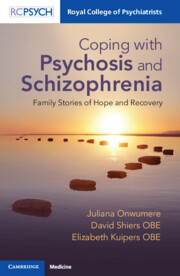Book contents
- Coping with Psychosis and Schizophrenia
- Reviews
- Coping with Psychosis and Schizophrenia
- Copyright page
- Epigraph
- Contents
- About the Authors
- Preface
- Acknowledgements
- 1 Understanding Psychosis and Schizophrenia
- 2 Parental Caregiver Accounts
- 3 Partner Caregiver Accounts
- 4 Sibling Caregiver Accounts
- 5 Child Caregiver Accounts
- 6 Extended Family Caregiver Account
- 7 Summary and Conclusions
- Helpful Resources
- References
- Index
1 - Understanding Psychosis and Schizophrenia
Published online by Cambridge University Press: 16 May 2024
- Coping with Psychosis and Schizophrenia
- Reviews
- Coping with Psychosis and Schizophrenia
- Copyright page
- Epigraph
- Contents
- About the Authors
- Preface
- Acknowledgements
- 1 Understanding Psychosis and Schizophrenia
- 2 Parental Caregiver Accounts
- 3 Partner Caregiver Accounts
- 4 Sibling Caregiver Accounts
- 5 Child Caregiver Accounts
- 6 Extended Family Caregiver Account
- 7 Summary and Conclusions
- Helpful Resources
- References
- Index
Summary
Psychosis is the generic name given to a range of illnesses that can affect the mind and interfere with how a person thinks, feels and behaves. The term psychosis covers several different conditions, for example, drug-induced psychosis, psychotic depression, schizoaffective disorder and schizophrenia spectrum disorders. The precise name used can change over time and will depend upon the pattern and length of difficulties that an individual has. A diagnosis of schizophrenia is considered the most severe type of psychotic illness and almost one person in every hundred people will be diagnosed at some point in their life. It used to be thought that schizophrenia was a discrete illness that was quite separate from other psychotic illnesses such as depressive psychosis.
- Type
- Chapter
- Information
- Coping with Psychosis and SchizophreniaFamily Stories of Hope and Recovery, pp. 1 - 12Publisher: Cambridge University PressPrint publication year: 2024

